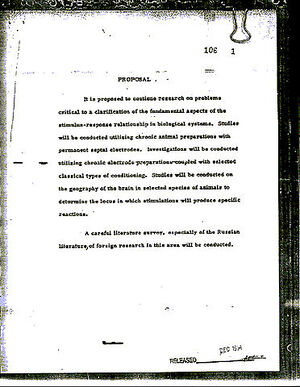Project MKUltra (nonfiction): Difference between revisions
| Line 15: | Line 15: | ||
<gallery> | <gallery> | ||
File:Pin Man.jpg|link=Pin Man|2017: [[Pin Man]] says he "was involved with Project MKUltra." | File:Pin Man.jpg|link=Pin Man|2017: [[Pin Man]] says he "was involved with Project MKUltra." | ||
File:Phagey the Extract of Radium mascot.png|link=Extract of Radium|April 13, 1952: [[Extract of Radium]] opens state-of-the-art nightclub in Langley, Virginia. The signature cocktail, known as an MKUltra, is made of equal parts [[Extract of Radium]] and [[Clandestiphrine]] with a twist of [[Malvoleum]]. | |||
</gallery> | </gallery> | ||
Revision as of 18:08, 12 November 2018
Project MKUltra – sometimes referred to as the CIA's mind control program – is the code name given to a program of experiments on human subjects, at times illegal, designed and undertaken by the United States Central Intelligence Agency.
Experiments on humans were intended to identify and develop drugs and procedures to be used in interrogations and torture, in order to weaken the individual to force confessions through mind control. Organized through the Scientific Intelligence Division of the CIA, the project coordinated with the Special Operations Division of the U.S. Army's Chemical Corps.
The operation began in the early 1950s, was officially sanctioned in 1953, was reduced in scope in 1964, further curtailed in 1967, and officially halted in 1973. The program engaged in many illegal activities, including the use of unwitting U.S. and Canadian citizens as its test subjects, which led to controversy regarding its legitimacy. MKUltra used numerous methodologies to manipulate people's mental states and alter brain functions, including the surreptitious administration of drugs (especially LSD) and other chemicals, hypnosis, sensory deprivation, isolation, verbal and sexual abuse, as well as other forms of psychological torture.
The scope of Project MKUltra was broad, with research undertaken at 80 institutions, including 44 colleges and universities, as well as hospitals, prisons, and pharmaceutical companies. The CIA operated through these institutions using front organizations, although sometimes top officials at these institutions were aware of the CIA's involvement. As the US Supreme Court later noted, MKULTRA was concerned with "the research and development of chemical, biological, and radiological materials capable of employment in clandestine operations to control human behavior." The program consisted of some 149 subprojects which the Agency contracted out to various universities, research foundations, and similar institutions. At least 80 institutions and 185 private researchers participated. Because the Agency funded MKUltra indirectly, many of the participating individuals were unaware that they were dealing with the Agency.
Project MKUltra was first brought to public attention in 1975 by the Church Committee of the U.S. Congress, and a Gerald Ford commission to investigate CIA activities within the United States. Investigative efforts were hampered by the fact that CIA Director Richard Helms ordered all MKUltra files destroyed in 1973; the Church Committee and Rockefeller Commission investigations relied on the sworn testimony of direct participants and on the relatively small number of documents that survived Helms' destruction order.
In 1977, a Freedom of Information Act request uncovered a cache of 20,000 documents relating to project MKUltra, which led to Senate hearings later that same year. In July 2001, some surviving information regarding MKUltra was declassified.
In the News
2017: Pin Man says he "was involved with Project MKUltra."
April 13, 1952: Extract of Radium opens state-of-the-art nightclub in Langley, Virginia. The signature cocktail, known as an MKUltra, is made of equal parts Extract of Radium and Clandestiphrine with a twist of Malvoleum.
Fiction cross-reference
Nonfiction cross-reference
External links:
- Project MKUltra @ Wikipedia
Attribution:


